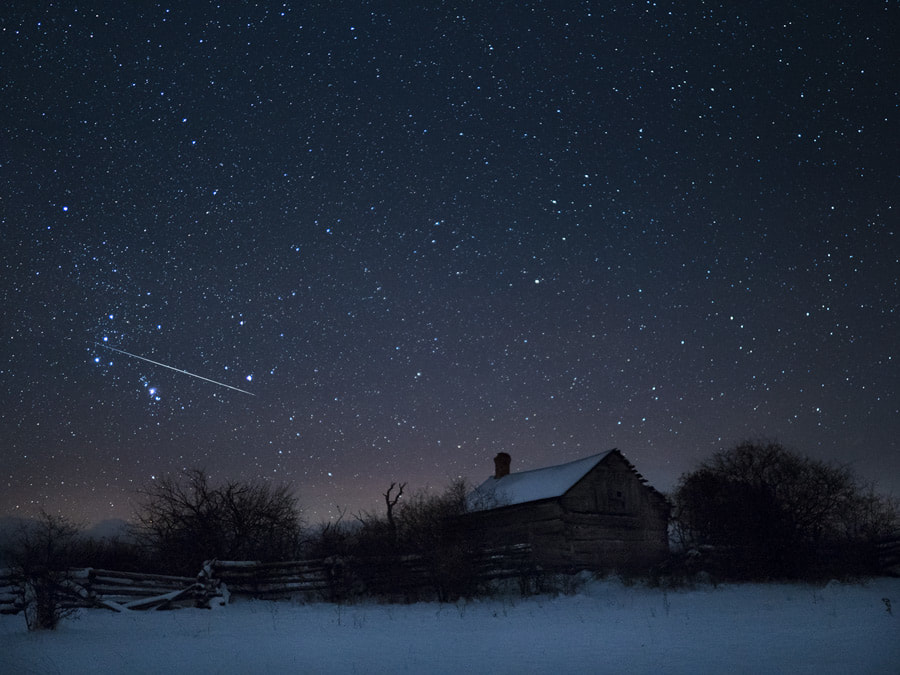|
At any time of the year, it is not uncommon to look into a clear night sky and see the occasional meteor streaking through the heavens. However, with each orbit around the sun, our little blue planet passes through several meteoroid streams that can produce upwards of one hundred meteors per hour - a meteor shower. These streams are created by orbiting comets that shed cosmic particles as they approach the sun. Photographing these celestial events can be a challenge, but with a bit of knowledge you can improve your chances of success. Knowing where and when a meteor shower will occur is the first step to a successful night shoot. These particles generally run parallel to the comet from which they came, and as such will appear to spread out from a single point in the sky. They are named for the nearest constellation or bright star from which they radiate. This 'fixed point' will track across the sky over the course of the night similar to the way that the stars do. The chart below lists the major meteor showers throughout the year, the best viewing dates, and their location in the sky.
Notes
Tips for Viewing a Meteor Shower
Tips for Photographing a Meteor Shower Okay, so you found a great spot, the conditions are perfect, and the meteors are flying. Let's photograph! Many of these tips apply to most types of night sky photography. If you are new to astrophotography check out my blog post that will get you on your way.
When is a Shooting Star Not a Shooting Star? With the naked eye it's difficult to confuse a meteor with any other activity in the night sky. Meteors move fairly quickly across the sky and usually only last for a second - sometimes more, sometimes less. They also increase in brightness and then fade out. But in a static image it can be difficult to tell what created the streak of light. Planes have strobes that create a characteristic connect-the-dot look in your image so there is usually no trouble identifying that in your photo. Satellites on the other hand reflect light from the sun and therefore create a streak of constant brightness from tip to tail. The photo above clearly shows the light increasing in intensity from left to right and then fading out quickly. Satellites don't do that, with one exception - iridium flares. The Iridium series of satellites have very reflective surfaces that create a brief, buy very noticeable flare as they pass overhead. They move slower than a meteor so are not likely to be mistaken for one to the naked eye, but in an image they can look quite similar. Using Live Composite If you are an Olympus shooter, your first inclination might be to use the Live Composite feature since it will capture all changes in light over the course of many minutes or hours. This will allow you to capture up to 3 hours of night sky activity in a single image. I would actually advise against this since the star trails will overlap any of the meteors that you capture, unless this is the effect you are looking for. Is there a way to photograph a bunch of meteors in one single shot? Sorry, but no. Over the course of a 25-30 second exposure it would be extremely unlikely that you would see more than two shooting stars. Those photos where you have seen a dozen or more meteors are composite images of several shots blended together. The image below is an example of one. This is a blending of 12 images using Photoshop and layer masking. Final Thoughts With a bit of planning, and a bit of luck it is quite possible to capture numerous meteors over the course of an hour or so of shooting. Just remember to make a wish after each one. Useful Links
Here are all the links referred to in the body of this post, plus a few others;
8 Comments
Ashley Wallis
4/18/2018 03:20:22 am
Hi Peter,
Reply
Peter
4/19/2018 09:14:08 am
Hi Ashley,
Reply
4/18/2018 01:42:29 pm
Excellent article, great writing style and organization! I appreciate that you shared this information with us.
Reply
Peter
4/19/2018 09:09:53 am
Thanks for taking the time to comment. Glad you found the article useful.
Reply
Debra
4/24/2020 10:11:54 am
Thank x 100. I live in the mts, in NM at high altitudes. The sky is incredible. However seems like i am always setting camera at last minute....always a 3 -stooges affair. Will follow all your sage advice. Head lamp is a great logical purchase.
Reply
Leave a Reply. |
AuthorPeter Baumgarten is a professional photographer and educator. He is also an Olympus Visionary and NiSi Official Photographer. Categories
All
|






